Flare control creams
This information is important for everyone with eczema. Even if you’ve been looking after your eczema for a while, you may find some new, helpful tips.
This section will look at;
- What are flare control creams?
- Are flare control creams safe?
- When do I need to use flare control creams?
- How do I use flare control creams?
- Golden Rules for using flare control creams
Watch this video to find out more about flare control creams and how to use them safely
I didn't think I would learn anything new as I've been dealing with my eczema for years but I found out some things I didn't know.
What are flare control creams?
Flare control creams are used to get control of eczema flare-ups. They contain medicines to make the skin less sore and itchy. This helps the skin heal. Most people with eczema will need to use flare control creams at some point.
What types of flare control creams are there?
These creams are normally prescribed and are usually steroid creams (topical corticosteroids). Sometimes people are prescribed TCIs (Topical Calcineurin Inhibitors). You can find out more about TCIs later on.
What are steroid creams?
Steroid creams are the most common type of flare control creams
Find out more
Steroid creams are the most common type of flare control creams.
The steroids in these creams are like the ones produced naturally by the body. They are very good at treating eczema flare-ups by reducing itching, and helping soreness and swelling. This helps the skin heal much quicker. They are not the same as the steroids sometimes taken by athletes or bodybuilders. These are called ‘anabolic steroids’. They have a very different use. They build muscle and are not used to treat eczema.
When I get a flare-up, I put the steroid cream on and it clears it right up.
Are steroid creams safe?
Yes. When steroid creams are used correctly they are very safe. They will help you to quickly get control of your eczema.
Read the evidence
|
A research team recently looked at all of the scientific evidence on steroid creams *&**. They wanted to see how safe steroid creams are for people to use on eczema. The team looked at information gathered from thousands of people across the world. These studies looked at people with eczema who used steroid creams to treat flare-ups or "weekend therapy" (more about this later) to prevent flare-ups. Very few people reported side effects, such as skin thinning, and these were mainly mild. One of the largest studies***. found that less than 1 in 1000 children using mild or moderate steroid creams for up to 5 years had skin thinning. In studies of people using strong (potent) steroid creams, less than 1 in 100 had any skin thinning. You can find out more about skin thinning and other side-effects later in the 'common questions' section. For updates about reviews on this topic go to the 'other resources' section for the latest scientific evidence about safety of steroid creams. * Axon E, Chalmers JR, Santer M, et alSafety of topical corticosteroids in atopic eczema: an umbrella reviewBMJ Open 2021;11:e046476. doi: 10.1136/bmjopen-2020-046476** Lax SJ, Harvey J, Axon E, Howells L, Santer M, Ridd MJ, Lawton S, Langan S, Roberts A, Ahmed A, Muller I, Ming LC, Panda S, Chernyshov P, Carter B, Williams HC, Thomas KS, Chalmers JR. Strategies for using topical corticosteroids in children and adults with eczema. Cochrane Database of Systematic Reviews 2022, Issue 3. Art. No.: CD013356. DOI: 10.1002/14651858.CD013356.pub2. Accessed 09 June 2022.*** Safety and Efficacy of Pimecrolimus in Atopic Dermatitis: A 5-Year Randomized Trial Bardur Sigurgeirsson, Andrzej Boznanski, Gail Todd, André Vertruyen, Marie-Louise A. Schuttelaar, Xuejun Zhu, Uwe Schauer, Paul Qaqundah, Yves Poulin, Sigurdur Kristjansson, Andrea von Berg, Antonio Nieto, Mark Boguniewicz, Amy S. Paller, Rada Dakovic, Johannes Ring, Thomas Luger Pediatrics Apr 2015, 135 (4) 597-606; DOI: 10.1542/peds.2014-1990 (The information about skin thinning is in the correspondence section of this paper) |
Common questions about flare control creams (usually steroids)
Although they are safe to use, we know that people with eczema sometimes worry about the side-effects of steroid creams. Here are some common questions that people with eczema have about steroid creams. Click the questions you want to find out more about.
Are steroid creams safe to use on broken skin?
|
Yes. They are safe to use on broken skin. Broken or cracked skin is common in eczema, and steroid creams are one of the best ways to help skin get back to normal. Information sheets that come with steroid creams sometimes say that they cannot be used on damaged or broken skin. This is because steroids are more easily absorbed into the body through broken skin. But if any is absorbed, it is such a small amount that it is extremely unlikely to have any effect on the body and is a much smaller amount of steroid than you would receive by mouth for a bad flare-up. It is better to get control of the eczema earlier with the steroid cream, even if skin is broken. |
My eczema was awful. The nurse convinced me to try the steroid ointment instead of cream. It was amazing – it didn’t sting and the eczema cleared up within days.
Do steroid creams thin the skin?
No. When used correctly, steroid creams do not thin the skin.
People often worry that steroid creams will thin their skin.
You may have heard about the serious side-effects of steroid creams in the 1960s and 1970s. Back then, steroid creams were new, and less was known about how best to use them. Because these creams were so good at treating eczema, many people were wrongly given very strong steroid creams to use non-stop over long periods (like every day for a year). This made the skin ‘thin’.
Doctors now know much more about steroid creams and how to use them safely without thinning the skin.
Should steroid creams sting?
Steroid creams can sting at first, but this will go away quickly.
Lots of people find that steroid creams sting when they are first put on the skin. This may happen if your skin is dry, cracked, or broken because of eczema.
Steroid creams will usually only sting for the first few days. This will stop when you get control of your eczema and your skin gets better.
If the stinging doesn’t go away after a few days, then you may want to tell your doctor. It may be that you are having a reaction to an ingredient in the cream. You may need to try a different steroid cream. An ointment may be better as they are less likely to sting.
The nurse told me that it might sting and to keep going, so I did and after a few days it went away.
Can steroid creams lighten, bleach, or darken the skin?
No. Steroid creams do not change the colour of your skin.
Your skin is more likely to change colour in patches (become lighter or darker) if eczema is under-treated. Eczema flare-ups make the skin itchy and sore, which can change the colour. This can make the skin have darker or lighter patches where eczema is.
Steroid creams can lower the chance of the skin changing colour by helping you get control of eczema. These patches of lighter or darker skin will go away once you get control of eczema, but it can sometimes take a long time for the skin to go back to normal.
Sometimes people think these patches are scars. It is very unusual for eczema to scar. When people with eczema get scars it is usually because of severe scratching. You can find out more about how to deal with this in the ‘beat the itch' section.
I used to have lighter patches of skin on my arm but now that I have my eczema under control they have disappeared.
When might I need to use a strong steroid cream?
Your doctor or nurse will prescribe the correct strength (potency) and amount to help you get control of your eczema.
What they give you will depend on how itchy and sore your skin is, and whether the eczema has made your skin ‘thick’. When the skin is thick, a stronger steroid cream can help bring the skin back to normal.
You may need to step up or step down between different strengths of steroid creams as you get control of your eczema.
Some parts of the body are more sensitive than others. These are the face, armpits, genitals, and bottom. Only put strong steroid creams on these areas if your doctor or nurse has told you to do this. You can find out about different strength steroid creams later in ‘finding the right flare control (steroid) cream’.
In the past, when steroids weren’t used safely, some skin did get thinner, but this usually went back to normal when the steroids were stopped. On the other hand, eczema damages the skin if you do not treat it.
Do steroid creams make eczema worse in the long term?
No, there is no evidence that steroid creams make eczema worse long-term.
Many people with eczema worry about how steroid creams will affect the course of their eczema. Some people also worry that treatments might make it worse.
There is no evidence that steroid creams – or, indeed, any other treatment for eczema – change how long eczema lasts, or makes it worse in the long-term.
What steroid creams do is help you to get control of eczema.
It is good to remember that eczema damages the skin if you do not treat it.
Do steroid creams affect growth and development?
No. Steroid creams are not thought to affect growth and development if used as recommended for a few days or weeks at a time.
Very little cream is absorbed into the body. Most stays on the surface of the skin.
More can be absorbed when using stronger creams. This can happen if the creams are being used in very large amounts all over the body, or on very sensitive parts of the body. Sensitive parts of the body are the face, armpits, genitals, and bottom.
For this reason, steroid creams are only used for a few days or weeks. If you need to use them every day for more than 4 weeks, it would be good to speak to your doctor or nurse.
Can my skin become dependent on steroid creams?
|
The information in this website is designed to help you use steroid creams safely. Rarely, skin reactions have been reported after long-term use of steroid creams, referred to as 'topical steroid withdrawal', ‘red skin syndrome’ or ‘topical steroid addiction.’ It is safe to use steroid creams for a few weeks or over a longer time with short breaks. But these rare skin reactions can occur when people have been using steroid creams every day without a break. It is common for eczema to return or flare-up shortly after stopping steroid creams. But if the flare-up seems severe or if you have been using steroid creams every day for a long time then please talk to your doctor, nurse or pharmacist. Most skin specialists find that they don't often see people who use too much steroid creams. But they do often see eczema that is worse than it should be because not enough steroid creams have been used. You can also find more information in the 'other resources' section in the ‘more about treatments’ section of this website, including information from the National Eczema Society, British Association of Dermatologists and UK Medicines and Healthcare products Regulatory Agency. |
When to use flare control creams
If you are not sure about whether you need flare control creams, or if you have never been prescribed these before but think you need them, then speak to your doctor or nurse about this.
When should I start using flare control creams?
It is best to start using flare control creams as soon as you spot a flare-up. This will help you get control quickly. It will help stop the flare getting worse, and will make it go away faster.
Top tip!
It's a good idea to always keep spare flare control cream in the house. This means that you can quickly treat any flare-ups as soon as they start. This will help you get control sooner.
What is a flare-up?
A flare-up is where the skin is more sore or itchy than usual. In lighter skin, an eczema flare-up may make the skin look red. Click on the pictures to make them bigger.
In darker skin, an eczema flare-up may make the skin look grey, purple, or brown.
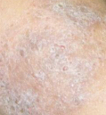

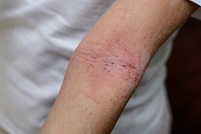
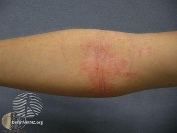
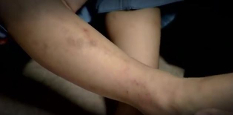
Find out what to do if you run out of flare control creams and cannot get to your doctor or nurse
There are two types of flare control creams that you can buy at the pharmacy without a prescription. They are:
- 1% hydrocortisone cream. This is a mild steroid cream.
- Eumovate (clobetasone butyrate 0.05%). This is a moderate steroid cream.
To get these creams you will need to speak to the pharmacist. You will only be able to buy these in small tubes. The pharmacist will ask you to speak to your doctor first if you are planning to use the cream:
- On sensitive areas of the body such as the eyes, face, armpits, bottom or genitals
- On children under 10 years old (hydrocortisone)
- On children under 12 years old (Eumovate)
If buying your own steroid cream then you should see your doctor or nurse to talk about how best to get control of your eczema unless you have already talked to them about buying steroid creams like this.
How long should I use flare control creams for?
It is important that you use flare control creams as prescribed. For most people, this will be:
1. Once a day during a flare-up and for 2 days after the skin has returned to normal.
Find out more
Most people will need to use flare control creams once a day when they get a flare-up. It is best to keep using the flare control cream for two days after the skin returns to normal and feels soft. Sometimes eczema can still be under the skin even when it looks OK. Using the cream for two more days will help make sure you treat all of it.
2. It usually takes 5-7 days to get control
Find out more
For a mild eczema flare-up, it usually takes 5-7 days to get control. For a thicker patch of eczema or more severe flare-up it may take a few weeks. If you need to use flare control creams for longer than 4 weeks then it would be good to discuss this with your doctor.
Your doctor may suggest 'weekend therapy' if your eczema is severe and you often get flare-ups.
What is weekend therapy?
Weekend therapy means using flare control creams two days a week on the areas that often get eczema. This can be any 2 days in the week. This can help stop these areas having as many flare-ups. So you will need less flare control cream in the long-run.
Weekend therapy is used when eczema is already under control but at risk of flare-up. If you think your eczema is severe and you often get flare-ups, then you could discuss weekend therapy with your doctor or nurse.
When using weekend therapy, you still need to use flare control creams once every day if you have a flare-up.
I was getting flare-ups all the time, so the doctor told me to do weekend therapy – using a steroid cream a couple of times a week. It’s been much better since then.
How much flare control cream should I use?
Many people are not sure about how much flare control cream to put on. As a rough guide, put on a thin layer, just enough to cover the eczema flare area.
Using too much
Sometimes people use more flare control cream to try to make eczema go away quicker. Studies show that using flare control creams once a day when you need them is just as effective as more often.
Using too little
Some people use too little flare control cream. This is not better for your skin and the creams will not work well like this. It may mean you need to use more in the long-run.
What is the best way to put on flare control creams?
It is a good idea to wash your hands – they may have bacteria on them that could make your flare-up worse or get infected.
Use downward strokes, in the same direction that the hair is growing. Do not rub it in, as rubbing can make you feel itchy.
Put a thin layer of cream on the areas that have flared-up (or if using ‘weekend therapy’, on areas that usually get flares).
It is safe to put steroid creams on broken skin. This may sting at first, but this will stop as the skin heals.
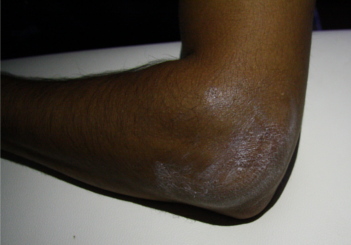
Wash the cream off your hands when you have finished, unless you have hand eczema. This is because flare control cream should only be used on the areas that need it.
Should I keep using moisturising creams (emollients)?
Yes. You will need to carry on using moisturising creams (emollients) every day to keep control of your eczema. This will help soothe the skin and prevent other flare-ups. Click the boxes for answers to some common questions about using moisturising creams and flare control creams together.
Do I need to leave a gap between putting on each cream?
It is best to leave a gap between putting on flare control creams and moisturising creams.
This allows the creams to soak in as moisturising creams may water down the flare control cream making it work less well.
Most doctors suggest leaving a gap of 20-30 minutes between the two treatments.
What order do I need to put them on in?
It doesn’t matter what order you put them on in.
Some people choose to put flare control creams on in the morning and moisturising creams on in the evening before they go to bed.
Other people prefer to apply them at set times during the day. Some people like to put moisturising creams on straight after a bath or shower and then put flare control creams on later. Whatever works for you!
I just set alarms for the different creams to remind me to put them on so I don't forget!'
Types and strengths of flare control cream
There are different types and strengths of flare control cream. It can feel frustrating when eczema isn’t getting better even when you are using the treatments as you’ve been told to. This section looks at how you can find a flare control cream that is right for you. This will usually be a steroid cream. Click the topics you want to find out more about.
What different flare control creams are there (e.g. creams, ointments)?
|
Steroid creams come in ointments, creams, or gels. Your doctor or nurse may prescribe an ointment when your eczema is dry or because ointments stay on the skin for longer. They are transparent and gel like. Because they are greasy they will help to add moisture to your skin. Some people don’t like the feel of ointments. They may prefer ‘creams’. Creams are white and contain a lot of water. They are light and cooling. They can feel easier to put on, but sometimes people feel that creams ‘sting’ more than ointments on broken skin. There are also special steroid gels or lotions that can be used to treat eczema on the scalp. These can help if you get an itchy scalp, particularly at night. The important thing is finding a treatment that is right for you. Sometimes the same steroid cream is available as different types, so it might be worth asking your doctor or nurse if you like a certain type more than others. |
I really hated the creams. They stung when I put them on. I went to the doctor and she gave me an ointment. That was much better.
What strengths of steroid cream are there?
Steroid creams come in four different strengths (potencies). These are:
Mild | Moderate | Strong (potent) | Very strong (very potent)
The strength of a steroid cream depends on how it was made. Different types of steroids are made of different chemical building blocks, making some stronger than others. This means that you can’t tell how strong a steroid cream is by looking at what % of steroid the cream has in it.
Your doctor or nurse will prescribe the right strength of cream to help you get control of your eczema. Mild eczema is usually treated with a mild treatment cream or ointment. Moderate or severe eczema, or eczema that is not getting better, will need a stronger cream or ointment.
If you are not sure how strong your steroid cream is, speak to your pharmacist, doctor, or nurse.
What strength of steroid cream should I use?
Mild eczema is usually treated with a mild steroid cream, such as hydrocortisone. Moderate or severe eczema, or eczema that is not getting better, will need a stronger cream.
Skin on the face, armpits, genitals, and bottom are more sensitive. Only mild or moderate steroid creams should be used on these areas unless you have been told something else by your doctor. This might happen if your eczema is quite bad in these areas, and needs a stronger treatment to get it under control.
On the other hand, thick skin areas such as the palms, soles of the feet and scalp will need moderate to strong steroid creams for them to work.
Your doctor will prescribe the correct strength (potency) of steroid cream to help you get control of your eczema. You may be given more than one steroid cream to treat eczema in different areas of the body. Make sure that you are clear which to use where. If in doubt, talk to your pharmacist or contact your doctor or nurse.
When should I change to a different strength of steroid cream?
When should I change to a different strength of steroid cream?
You should always use the mildest steroid cream that will treat your eczema flare. As you get control of your eczema, you may need to step down between different strengths of steroid creams until your eczema is back under control.
If your eczema is not getting better then you may need to change to a stronger steroid cream.
If you think you need to change to a different strength steroid cream you should speak to your doctor to make sure that you get the right strength. It is very important you only use the cream on the person it has been prescribed for. Different steroid creams are usually given to babies, children, and adults.
You can find information on how to read the labels on the packaging of your treatments in the ‘other resources’ section which you can get to from the menu bar above.
To get control
Flare control creams (usually steroid creams)
What are they for?
These creams are used to get control of eczema. They are:
• Used to treat sore and itchy skin
• Normally prescribed and are usually steroid creams (topical corticosteroids). Sometimes they are TCIs (Topical Calcineurin Inhibitors)
Most people with eczema will need to use flare control creams at some point.
When?
Use them as soon as there is a flare-up.
How often?
During a flare-up, apply a thin layer once a day until the eczema is under control.
How much to apply?
As a rough guide, put on a thin layer, just enough to cover the eczema flare area.
How long for?
Use them for two days after the eczema is under control. If you need to use flare control creams for longer than 3 or 4 weeks, then it would be good to discuss this with a health professional.
Are they safe?
Yes. Studies show that flare control creams are safe when used following the instructions above. They should be applied to the affected skin only. They are usually used for just a few days or weeks at a time.
This is the end of the flare control creams section. Click here to view the section on moisturising creams or you can browse the menu at the top of the page.
